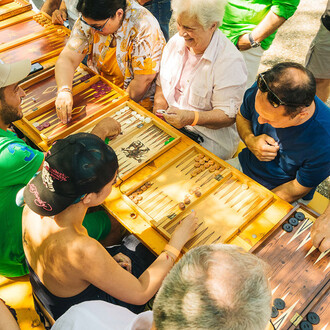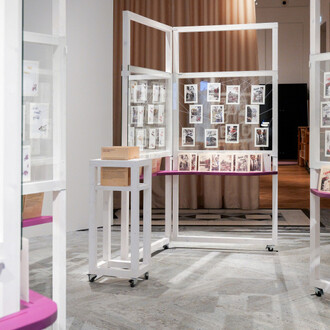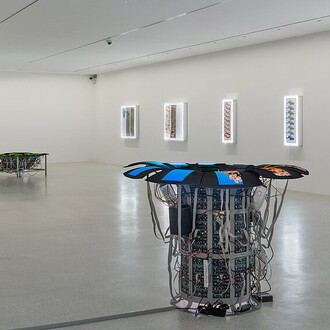The end of the Cold War not only brought about the end of the bipolar world order. Also, certainties and commitments have since been diminished or have completely disappeared. The commitment of intersubjective knowledge has meanwhile parcelled itself into countless voluntaristic worlds of knowledge that compete with each other. Pandemic, terror and war, climate change and artificial intelligence have further reinforced the new complexity and uncertainty. The post-factual and the increasing virtualization of the experience realm therefore pose ever more urgently the question regarding which role perception and knowledge play today for the understanding of the world, that is, for the construction of reality. Perspectival perplexity can be observed also in the art of the previous three decades.
Documentary approaches, the compilation and evaluation of archives, social and political engagement in questions of identity politics – these and similar proceedings characterise broad areas of today’s artistic production. What apparently connects them is the conviction that acquisition, possession, and dissemination of knowledge are of paramount importance. The investigation of the conditions and structures of awareness and their role in cognition, therefore the questioning of knowledge, seems in contrast to be of secondary importance. This “aisthesis”, ancient Greek for sense perception, was already a frequently discussed term in ancient philosophy. With all the rational, metaphysical, or eschatological dimensions of its interpretation, it was always understood as one of the sources for the creation of world-knowledge, to which the intellectually acquired knowledge acts complementarily.
The experience of the world through the senses was always a foundation of artistic reflection and production, since, in contrast to abstract thinking, the “aisthesis” with its synaesthetic qualities can lead to insights which rationally are not (yet?) accessible. The question “what do I want to know?” is aimed first and foremost at insight as a result of awareness. It requires self-reflective conduct, for example via questions such as: with which methods do I arrive at insight? Is certain insight at all possible? What are truth and reality? Productive doubt, curiosity, love of experimentation and, concurrently, situatedness in the context of truth and reality are the driving forces. The artistic positions in this exhibition have in common that they grapple with the interrelation of knowledge and awareness, the “aisthesis” as source of awareness and insight as a path to knowledge.
On the one hand, in their strategies a methodical proximity to scientific epistemological theory is apparent; on the other hand, the artists investigate in experimental ways the insight-potential and metaphor-potential of material and process for the creation of pictures. In this manner they do not provide – and this is a fundamental strength of art – any answers to questions. It is much more the case that their experiments and their products are an inducement to further experiments, to further questions. Questions regarding the reliability of knowledge, questions about the insight potential of awareness, questions about the senses and the function of thought, and ultimately also questions about the insight potential of art.
Lia Perjovschi (1961) in 2024 created a diagram on the relationship between knowledge and awareness. These diagrams have arisen since 1999; in them, the artist brings together quotations, concepts, questions, and definitions that she has selected, and structures them in a sort of Mind map radially around the respective thematic centre. She thereby consciously abstains from clusters and/or hierarchies. Knowledge and perception stands in a deductive thematic line of her work, beginning with the (performative) investigation of physical and psychic dimensions of the human body (Hands, 1993, video), and continuing in diagrams such as Subject/ID (1999–2006) and Info age (2020).
Perjovsch’s diagrams, together with additional collected, selected, and archived information, constitute the knowledge inventory of the Knowledge museum that she has made accessible in physical form in her studio in Sibiu. She views this as a platform of “selected” knowledge, in order to stimulate the exchange of ideas, discussions, and further debates.
The complexity of human nature and the situatedness of art are the central themes of Thomas Lehnerer (1955-1995). He has pursued these concepts both intellectually as well as visually-artistically. In his writing Methode der kunst [methods of art] (1994) he thus developed a distinct art theory which can be read as an attempt to pull in a base of liability for the growing artistic Anything goes of the post Modernity in the 1980s by means of the central term of “free play” within every regulatory framework. In his individual drawings and groups of drawings as well as in his sculptures, he traces these latitudes, amongst others by the compilation of groups of drawings on the four basic questions of the philosophy of Immanuel Kant (Belgrade Project, 1988) or the visualisation of the process of the creation of artistic ideas (Thinking in art, 1987). Little methods from 1989 in turn visualises the various fundamental modes of sculptural design.
Tomas Schmit (1943-2006), after initial actions in the 1960s in the context of the Fluxus activities, dedicated himself to the large-scale project “of a central aesthetic”, as it is called in the title of his book erster entwurf [first draft] (1989). This book represents an exemplary introduction to the physiological and psychological conditions of sensory perception. Furthermore, in numerous drawings he visualises his observations and deliberations on the functioning of awareness and on the development of “consciousness”. With a great sense of humour he thereby continually makes clear the conventions of apparently firmly entrenched forms of logic, for example linguistic determinations which are often confused with the content that they signify (eine kalbe scheibsleber bitte, 1994). And he reveals the arbitrariness of the correlation of perception and consciousness (das höhlengleichnis [the allegory of the cave], 1994). Again and again, in addition he analyses, in playful fashion and with sympathy for internal contradictions, the boundaries and meaningfulness of utopian ideas (die quadratur des kreises, 1972; small utopian, 1978).
Thom Barth (1951) shares with many of his generation the attitude that the world in which we live is more and more shaped by pictures, notions, and thoughts of the second, third, etc. degree, and that its appearance recedes behind its images. Against this increasingly mediatising reality, in his artistic work he poses questions regarding its situatedness. The most important medium for this is transparent film, as encountered print film with existing images and/or fragments of images, or as self-made photocopies. Fugitiveness and provisionality always appertain to these images; the images depicted on them allow no material character, instead appearing as disembodied and ghostly. The combination with the semantic of the material basis of image carriers such as window frames reinforces this effect (window, 1994, topview, 1995). In additional groups of works, Barth enlarges an initial motif, in countless steps, until it is unrecognizable. Paradoxically, via further enlargements, new pictorial motifs emerge which no longer have any contentual or formal relationship to the initial motif: new pictorial worlds arise which provide the occasion for additional processing, for example via painting as in the group x-grau from 1999.
Methodologically comparable is the artistic work of Magda Csutak (1945), nevertheless with a focal point inclining towards a science-oriented method of systematics. Her central interest is directed towards the image-copy problematic and the role that materials play in this (Still Leben X-5L, 1995; Ich fange das Licht, es wird schwarz, 1997-98). For Csutak this is essentially intermediary, that is, communicative, in nature. Her individual works and groups of works are always experiments in the consolidation and juxtaposition of materials and their visual effects, on the basis of underlying questions that might be mathematical, linguistic, or even chemical-physical in nature. Her pictorial findings therefore exhibit an essentially informative impulse that addresses the conventional boundaries of the general understanding of material, form, process, and effect. Csutak’s work is therefore to be understood as an attempt to elicit from the materials and their characteristics their metaphoric potential for an understanding of the world (Die Annäherung an die Null, 2002).
Edith Dekyndt (1960) concerns herself with socio-cultural and social-political issues and consistently interweaves these with the visualisation of physical and chemical processes and phenomena that take place in our daily life without our being aware of them. In Underground 05 (Tournai), 2017, she buried part of a width of material in the ground and left it there for months. In the end result, the process of rotting on this part of the fabric is visible, in contrast to the undamaged rest of the fabric. In a new group of works, she works with maize, as a starting material for the 3-D overprinting of part of a forked branch she found (Billy Jack, 2024) or as structural and colour basis for a small-format wall work with a very painterly effect (La Vallée – Yellow, 2023). In these works she makes the effect of time, as well as processes of alteration and decay, legible, therefore transferring traditional formal concerns of artistic work into the sphere of “natural” reality. The consequences are considerable: knowledge, perception, and reality are thematised in very concrete ways and at the same time questioned.
Mircea Nicolae (1980-2020), in the group of works Prostheses, 2010-14, also concerns himself with materials from nature, yet his focus lies on their form and “subjectivity”. In a psychologizing procedure, he pursues their “healing” with the aid of their supplementation with a pendant developed for each object and made out of artificial materials (Prosthesis for a dry plant, Prosthesis for a broken stone). This “therapeutic” procedure is at the same time evidence for the significance of form and colour for the visual appearance of an object. The project realised later, Pretext for a Morandi, 2016-2017, also follows this thematic direction. In public space, Nicolae set up an arrangement of collected objects that could be a model for a painting by the Italian painter Giorgio Morandi (1890-1964). Subsequently, Nicolae, from his own arrangement, produced two paintings in the style of Morandi. Through his work, he traces the myth of the revelation of the “magic” of things in Morandi’s painting back to the basis of facts, and makes transparent the mechanisms of awareness and its significance for the emergence of insight and knowledge.
(Text by Friedemann Malsch, translation by Sarah Cormack)
















